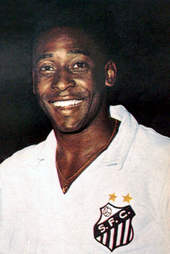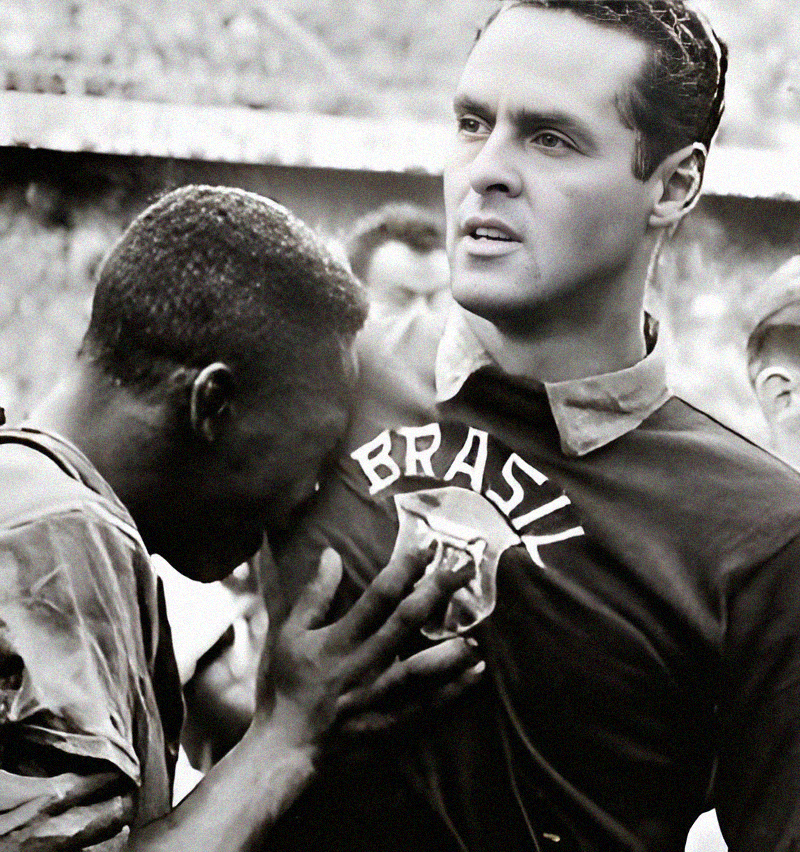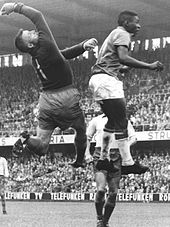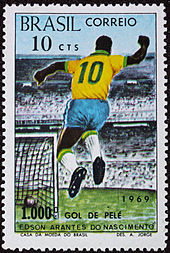PELÉ
Edson Arantes do Nascimento (Brazilian Portuguese: [ˈɛtsõ (w)ɐˈɾɐ̃tʃiz du nɐsiˈmẽtu]; born 23 October 1940), known as Pelé(Brazilian Portuguese: [pe̞ˈlɛ]), is a retired Brazilian professional footballer who played as a forward. He is widely regarded as the greatest football player of all time. In 1999, he was voted World Player of the Century by the International Federation of Football History & Statistics (IFFHS). That same year, Pelé was elected Athlete of the Century by the International Olympic Committee. According to the IFFHS, Pelé is the most successful league goal-scorer in the world, scoring 1281 goals in 1363 games, which included unofficial friendlies and tour games. During his playing days, Pelé was for a period the best-paid athlete in the world.
Pelé began playing for Santos at age 15 and the Brazil national football team at 16. During his international career, he won three FIFA World Cups: 1958, 1962 and 1970, being the only player ever to do so. Pelé is the all-time leading goalscorer for Brazil with 77 goals in 92 games. At club level he is also the record goalscorer for Santos, and led them to the 1962 and 1963 Copa Libertadores. Pelé's "electrifying play and penchant for spectacular goals" made him a star around the world, and his club team Santos toured internationally in order to take full advantage of his popularity. Since retiring in 1977, Pelé has been a worldwide ambassador for football and has made many acting and commercial ventures. In 2010, he was named the Honorary President of the New York Cosmos.
Pelé has also been known for connecting the phrase "The Beautiful Game" with football. A prolific goalscorer, Pelé was known for anticipating his opponents' movements in the field, and being able to shoot strong and accurate shots with both feet. Early in his career, he played in a variety of attacking formations. In his later career, he played in a playmaking role behind offensive strikers. In Brazil, he is hailed as a national hero for his accomplishments in football and for his outspoken support of policies that improve the social conditions of the poor. Throughout his career and in his retirement, Pelé received several individual and team awards for his performance in the field, his record-breaking achievements, and legacy in the sport
Early years
Pelé was born on 23 October 1940, in Três Corações, Minas Gerais, Brazil, the son of Fluminense footballer Dondinho (born João Ramos do Nascimento) and Celeste Arantes. He was the elder of two siblings.[1] He was named after the American inventor Thomas Edison.[2] His parents decided to remove the "i" and call him "Edson", but there was a mistake on the birth certificate, leading many documents to show his name as "Edison", not "Edson", as he is called.[2][3] He was originally nicknamed "Dico" by his family.[1][4] He received the nickname "Pelé" during his school days, when it is claimed he was given it because of his pronunciation of the name of his favorite player, local Vasco da Gama goalkeeper Bilé, which he misspoke but the more he complained the more it stuck. In his autobiography, Pelé stated he had no idea what the name means, nor did his old friends.[1] Apart from the assertion that the name is derived from that of Bilé, and that it is Hebrew for "miracle" (פֶּ֫לֶא), the word has no known meaning in Portuguese.[note 1][5]
Pelé grew up in poverty in Bauru in the state of São Paulo. He earned extra money by working in tea shops as a servant. Taught to play by his father, he could not afford a proper football and usually played with either a sock stuffed with newspaper and tied with a string or a grapefruit.[6][1] He played for several amateur teams in his youth, including Sete de Setembro, Canto do Rio, São Paulinho, and Amériquinha.[7] Pelé led Bauru Athletic Club juniors (coached by Waldemar de Brito) to two São Paulo state youth championships.[8] In his mid-teens, he played for an indoor football team called Radium. Indoor football had just become popular in Bauru when Pelé began playing it. He was part of the first Futebol de Salão (indoor football) competition in the region. Pelé and his team won the first championship and several others.[9]
According to Pelé, indoor football presented difficult challenges; he said it was a lot quicker than football on the grass and that players were required to think faster because everyone is close to each other in the pitch. Pelé accredits indoor football for helping him think better on the spot. In addition, indoor football allowed him to play with adults when he was about 14-years-old. In one of the tournaments he participated, he was initially considered too young to play, but eventually went on to end up top scorer with fourteen or fifteen goals. "That gave me a lot of confidence", Pelé said, "I knew then not to be afraid of whatever might come".[9]
Club career
Santos
In 1956, de Brito took Pelé to Santos, an industrial and port city located near São Paulo, to try out for professional club Santos FC, telling the directors at Santos that the 15-year-old would be "the greatest football player in the world."[10] Pelé impressed Santos coach Lula during his trial at the Estádio Vila Belmiro, and he signed a professional contract with the club in June 1956.[11] Pelé was highly promoted in the local media as a future superstar. He made his senior team debut on 7 September 1956 at the age of 15 against Corinthians Santo Andre and had an impressive performance in a 7–1 victory, scoring the first goal in his prolific career during the match.[12][13]
When the 1957 season started, Pelé was given a starting place in the first team and, at the age of 16, became the top scorer in the league. Ten months after signing professionally, the teenager was called up to the Brazil national team. After the 1962 World Cup, wealthy European clubs such as Real Madrid, Juventus and Manchester United tried to sign him, but the government of Brazil under President Jânio Quadros had declared Pelé an "official national treasure" the year before to prevent him from being transferred out of the country.[6][14]
Pelé won his first major title with Santos in 1958 as the team won the Campeonato Paulista; Pelé would finish the tournament as top scorer with 58 goals,[15] a record that stands today. A year later, he would help the team earn their first victory in the Torneio Rio-São Paulo with a 3–0 over Vasco da Gama.[16] However, Santos was unable to retain the Paulista title. In 1960, Pelé scored 33 goals to help his team regain the Campeonato Paulista trophy but lost out on the Rio-São Paulo tournament after finishing in 8th place.[17] In the 1960 season, Pelé scored 47 goals and helped Santos retain the Campeonato Paulista. The club went on to win the Taça Brasil that same year, beating Bahia in the finals; Pelé finished as top scorer of the tournament with 9 goals. The victory allowed Santos to participate in the Copa Libertadores, the most prestigious club tournament in the Western hemisphere.[18]
"I arrived hoping to stop a great man, but I went away convinced I had been undone by someone who was not born on the same planet as the rest of us."
—Benfica goalkeeper Costa Pereira following the loss to Santos in 1962.[19]
Santos's most successful Copa Libertadores season started in 1962;[20] the team was seeded in Group One alongside Cerro Porteño and Deportivo Municipal Bolivia, winning every match of their group but one (a 1–1 away tie versus Cerro). Santos defeated Universidad Católica in the semifinals and met defending champions Peñarol in the finals. Pelé scored twice in the playoff match to secure the first title for a Brazilian club.[21] Pelé finished as the second top scorer of the competition with four goals. That same year, Santos would successfully defend the Campeonato Brasileiro (with 37 goals from Pelé) and the Taça Brasil (Pelé scoring four goals in the final series against Botafogo). Santos would also win the 1962 Intercontinental Cupagainst Benfica.[22] Wearing his number 10 shirt, Pelé produced one of the best performances of his career, scoring a hat-trick in Lisbon as Santos won 5–2.[23][24] As the defending champions, Santos qualified automatically to the semi-final stage of the 1963 Copa Libertadores. The ballet blanco, the nickname given to Santos for Pelé, managed to retain the title after victories over Botafogo and Boca Juniors. Pelé helped Santos overcome a Botafogo team that contained Brazilian legends such as Garrincha and Jairzinho with a last-minute goal in the first leg of the semi-finals which made it 1–1. In the second leg, Pelé scored a hat-trick in the Estádio do Maracanã as Santos won, 0–4, in the second leg. Santos started the final series by winning, 3–2, in the first leg and defeating Boca Juniors 1–2, in La Bombonera. It was a rare feat in official competitions, with another goal from Pelé.[25] Santos became the first (and to date the only) Brazilian team to lift the Copa Libertadores in Argentine soil. Pelé finished the tournament with 5 goals. Santos lost the Campeonato Paulista after finishing in third place but went on to win the Rio-São Paulo tournament after a 0–3 win over Flamengo in the final, with Pelé scoring one goal. Pelé would also help Santos retain the Intercontinental Cup and the Taça Brasil against Milan and Bahia respectively.[22]
In the 1964 Copa Libertadores, Santos were beaten in both legs of the semi-finals by Independiente. The club won the Campeonato Paulista, with Pelé netting 34 goals. Santos also shared the Rio-São Paulo title with Botafogo and won the Taça Brasil for the fourth consecutive year. In the 1965 Copa Libertadores, Santos reached the semi-finals and met Peñarol in a rematch of the 1962 final. After two matches, a playoff was needed to break the tie.[26] Unlike 1962, Peñarol came out on top and eliminated Santos 2–1.[26] Pelé would, however, finish as the topscorer of the tournament with eight goals.[27] This proved to be the start of a decline as Santos failed to retain the Torneio Rio-São Paulo. In 1966, Pelé and Santos also failed to retain the Taça Brasil as Pelé's goals were not enough to prevent a 9–4 defeat by Cruzeiro (led by Tostão) in the final series. The club did, however, win the Campeonato Paulista in 1967, 1968 and 1969. On 19 November 1969, Pelé scored his 1000th goal in all competitions, in what was a highly anticipated moment in Brazil. The goal, popularly dubbed O Milésimo (The Thousandth), occurred in a match against Vasco da Gama, when Pelé scored from a penalty kick, at the Maracanã Stadium.[28]
Pelé states that his most memorable goal was scored at Rua Javari stadium on a Campeonato Paulista match against São Paulo rival Clube Atlético Juventus on 2 August 1959. As there is no video footage of this match, Pelé asked that a computer animation be made of this specific goal.[29] In March 1961, Pelé scored the gol de placa (goal worthy of a plaque), against Fluminense at the Maracanã.[30] Pelé received the ball on the edge of his own penalty area, and ran the length of the field, eluding opposition players with feints, before striking the ball beyond the goalkeeper.[30] A plaque was commissioned with a dedication to "the most beautiful goal in the history of the Maracanã".[31]
In 1967, the two factions involved in the Nigerian Civil War agreed to a 48-hour ceasefire so they could watch Pelé play an exhibition game in Lagos.[32] During his time at Santos, Pelé played alongside many gifted players, including Zito, Pepe, and Coutinho; the latter partnered him in numerous one-two plays, attacks, and goals.[33]
International career
Pelé's first international match was a 2–1 defeat against Argentina on 7 July 1957 at the Maracanã.[37][38] In that match, he scored his first goal for Brazil aged 16 years and nine months to become the youngest player to score in international football.[39]
1958 World Cup
Pelé arrived in Sweden sidelined by a knee injury but on his return from the treatment room, his colleagues stood together and insisted upon his selection.[40] His first match was against the USSR in the third match of the first round of the 1958 FIFA World Cup, where he gave the assist to Vavá's second goal.[41] He was the youngest player of that tournament, and at the time the youngest ever to play in the World Cup.[note 2][38] Against France in the semifinal, Brazil was leading 2–1 at halftime, and then Pelé scored a hat-trick, becoming the youngest in World Cup history to do so.[43]
On 29 June 1958, Pelé became the youngest player to play in a World Cup final match at 17 years and 249 days. He scored two goals in that final as Brazil beat Sweden 5–2 in Stockholm, the capital. His first goal where he flicked the ball over a defender before volleying into the corner of the net, was selected as one of the best goals in the history of the World Cup.[44] Following Pelé's second goal, Swedish player Sigvard Parling would later comment; "When Pelé scored the fifth goal in that Final, I have to be honest and say I felt like applauding".[45] When the match ended, Pelé passed out on the field, and was revived by Garrincha.[46] He then recovered, and was compelled by the victory to weep as he was being congratulated by his teammates. He finished the tournament with six goals in four matches played, tied for second place, behind record-breaker Just Fontaine, and was named best young player of the tournament.[47]
It was in the 1958 World Cup that Pelé began wearing a jersey with number 10. The event was the result of disorganization: the leaders of the Brazilian Federation did not send the shirt numbers of players and it was up to FIFA to choose the number 10 shirt to Pelé who was a substitute on the occasion.[48] The press proclaimed Pelé the greatest revelation of the 1958 World Cup, and he was also retroactively given the Silver Ball as the second best player of the tournament, behind Didi.[45]
1962 World Cup
When the 1962 World Cup started, Pelé was the best rated player in the world at the time.[51] In the first match of the 1962 World Cup in Chile, against Mexico, Pelé assisted the first goal and then scored the second one, after a run past four defenders, to go up 2–0.[52] He injured himself in the next game while attempting a long-range shot against Czechoslovakia.[53] This would keep him out of the rest of the tournament, and forced coach Aymoré Moreira to make his only lineup change of the tournament. The substitute was Amarildo, who performed well for the rest of the tournament. However, it was Garrincha who would take the leading role and carry Brazil to their second World Cup title, after beating Czechoslovakia at the final in Santiago.[54]
1966 World Cup
Pelé was the most famous footballer in the world during the 1966 World Cup in England, and Brazil fielded some world champions like Garrincha, Gilmar and Djalma Santos with the addition of other stars like Jairzinho, Tostão and Gérson, leading to high expectations for them.[55] Brazil was eliminated in the first round, playing only three matches.[55] The World Cup was marked, among other things, for foulings on Pelé that left him injured by the Bulgarian and Portuguese defenders.[56]
Pelé scored the first goal from a free kick against Bulgaria, becoming the first player to score in three successive FIFA World Cups, but due to his injury, a result of persistent fouling by the Bulgarians, he missed the second game against Hungary.[55] Brazil lost that game and Pelé, although still recovering, was brought back for the last crucial match against Portugal at Goodison Park in Liverpool by the Brazilian coach Vicente Feola. Feola changed the entire defense, including the goalkeeper, while in midfield he returned to the formation of the first match. During the game, Portugal defender João Morais fouled Pelé, but was not sent off by referee George McCabe.[57] Pelé had to stay on the field limping for the rest of the game, since substitutes were not allowed at that time.[57] After this game he vowed he would never again play in the World Cup, a decision he would later change.[51]
1970 World Cup
Pelé was called to the national team in early 1969, he refused at first, but then accepted and played in six World Cup qualifying matches, scoring six goals.[58] The 1970 World Cup in Mexico was expected to be Pelé's last. Brazil's squad for the tournament featured major changes in relation to the 1966 squad. Players like Garrincha, Nilton Santos, Valdir Pereira, Djalma Santos and Gilmar had already retired. However, Brazil's 1970 World Cup squad, which included players like Pelé, Rivelino, Jairzinho, Gérson, Carlos Alberto Torres, Tostãoand Clodoaldo, is often considered to be the greatest football team in history.[59][60]
| Matches | Goals | Ratio | |
|---|---|---|---|
| Domestic Tournaments | 702 | 656 | 0.94 |
| International Tournaments | 18 | 24 | 1.33 |
| Brazil national football team | 92 | 77 | 0.84 |
| Official | 812 | 757 | 0.93 |
| Friendly matches and defunct Tournaments | 554 | 526 | 0.95 |
| Total | 1366 | 1283 | 0.94 |
| Matches | Goals | Ratio | |
|---|---|---|---|
| International matches (Official and Friendlies) | 503 | 479 | 0.95 |
| Domestic matches (Official and Friendlies) | 863 | 804 | 0.93 |
| Total | 1366 | 1283 | 0.94 |
| Matches | Goals | Ratio | |
|---|---|---|---|
| Santos FC[177] | 1116 | 1091 | 0.98 |
| New York Cosmos[177] | 111 | 65 | 0.59 |
| Brazil | 114 | 95 | 0.83 |
| Other | 25 | 32 | 1.28 |
| Total | 1366 | 1283 | 0.94 |
After retirement
Since retiring, Pelé has continued to be lauded by players, coaches, journalists and others. Brazilian attacking midfielder Zico, who represented Brazil at the 1978, 1982 and 1986 FIFA World Cup, stated; "This debate about the player of the century is absurd. There's only one possible answer: Pelé. He's the greatest player of all time, and by some distance I might add".[45] French three time Balon D'or winner Michel Platini said; "There's Pelé the man, and then Pelé the player. And to play like Pelé is to play like God." Joint FIFA Player of the Century, Argentina's 1986 FIFA World Cup-winning captain Diego Maradona stated; "It's too bad we never got along, but he was an awesome player".[45] Prolific Brazilian striker Romário, winner of the 1994 FIFA World Cup and player of the tournament; "It's only inevitable I look up to Pelé. He's like a God to us".[45] Four-time FIFA Ballon d'Or winner Cristiano Ronaldo said: "Pelé is the greatest player in football history, and there will only be one Pelé", while José Mourinho, two-time UEFA Champions League winning manager, commented; "I think he is football. You have the real special one – Mr. Pelé."[90] Real Madrid honorary president and former player, Alfredo Di Stéfano, opined; "The best player ever? Pelé. Lionel Messi and Cristiano Ronaldo are both great players with specific qualities, but Pelé was better".[91]
Presenting Pelé a lifetime achievement award, former South African president Nelson Mandela said; "To watch him play was to watch the delight of a child combined with the extraordinary grace of a man in full."[92] US politician and political scientist Henry Kissinger stated, "Performance at a high level in any sport is to exceed the ordinary human scale. But Pelé's performance transcended that of the ordinary star by as much as the star exceeds ordinary performance."[93] After a reporter asked if his fame compared to that of Jesus, Pelé in response quipped, "There are parts of the world where Jesus Christ is not so well known."[70]
In 1999, the International Federation of Football History & Statistics (IFFHS) voted Pelé the World Player of the Century. That same year, the International Olympic Committeeelected him the Athlete of the Century. According to the IFFHS, Pelé is the most successful league goal-scorer in the world, scoring 1281 goals in 1363 games, which included unofficial friendlies and tour games. During his playing days, Pelé was for a period the highest-paid athlete in the world. Pelé's "electrifying play and penchant for spectacular goals" made him a star around the world. To take full advantage of his popularity, his team Santos toured internationally.[32] During his career, he became known as "The Black Pearl" (A Pérola Negra), "The King of Football" (O Rei do Futebol), "The King Pelé" (O Rei Pelé) or simply "The King" (O Rei).[










Comments
Post a Comment